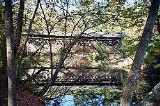
Pool's Mill Covered Bridge
Encyclopedia
Poole's Mill Bridge is a historic century-old wooden covered bridge
crossing over Settendown Creek in Forsyth County
, Georgia
, United States
. Circa 1820 Cherokee
Chief George Welch constructed a grist mill, saw mill, and a simple open bridge at the site on this tributary of the Etowah River
. Welch continued to run and maintain the mills and bridge until the Cherokee removal
in 1838.
The land that held the bridge and mills was won in the land lottery by John Maynard of Jackson County
, Georgia
who sold the land to Jacob Scudder. Following Scudder's death in 1870 the mill and bridge were bought by Dr. M.L. Pool. A cotton gin was added at the site in 1920 but cotton was all but abandoned by local farmers when the poultry industry was introduced. The mill was left in disuse by 1947 and was burned by vandals in 1959.
The original bridge that stood at the site was washed away in a flood in 1899. It was decided that a new bridge in using the Lattice truss bridge style would be built on the site. The design called for wooden pegs to be driven holes bored into wooden beams to hold the design together. The beams were cut on site at the saw mill but unfortunately the holes were bored in the wrong positions. At this point the construction was taken over by Bud Gentry who oversaw the re-drilling of the holes. The mis-drilled holes can still be seen in the bridge's beams.
In the mid 1990s the bridge began to sag and a revitialization effort began. A support pier was built in the creek in the middle. During this revitialization private citizens also donated land in the area to allow the creation of Poole's Mill Park.
Covered bridge
A covered bridge is a bridge with enclosed sides and a roof, often accommodating only a single lane of traffic. Most covered bridges are wooden; some newer ones are concrete or metal with glass sides...
crossing over Settendown Creek in Forsyth County
Forsyth County, Georgia
Forsyth County is a county located in the U.S. state of Georgia. The county seat is Cumming, Georgia. Forsyth County is a part of the Atlanta metropolitan area...
, Georgia
Georgia (U.S. state)
Georgia is a state located in the southeastern United States. It was established in 1732, the last of the original Thirteen Colonies. The state is named after King George II of Great Britain. Georgia was the fourth state to ratify the United States Constitution, on January 2, 1788...
, United States
United States
The United States of America is a federal constitutional republic comprising fifty states and a federal district...
. Circa 1820 Cherokee
Cherokee
The Cherokee are a Native American people historically settled in the Southeastern United States . Linguistically, they are part of the Iroquoian language family...
Chief George Welch constructed a grist mill, saw mill, and a simple open bridge at the site on this tributary of the Etowah River
Etowah River
The Etowah River is a waterway that rises northwest of Dahlonega, Georgia, north of Atlanta. Its name is the Cherokee version of the original Muskogee word Etalwa, which means a "trail crossing". On Matthew Carey's 1795 map the river was labeled "High Town River"...
. Welch continued to run and maintain the mills and bridge until the Cherokee removal
Cherokee removal
Cherokee removal, part of the Trail of Tears, refers to the forced relocation between 1836 to 1839 of the Cherokee Nation from their lands in Georgia, Texas, Tennessee, Alabama, and North Carolina to the Indian Territory in the Western United States, which resulted in the deaths of approximately...
in 1838.
The land that held the bridge and mills was won in the land lottery by John Maynard of Jackson County
Jackson County, Georgia
Jackson County is a county located in the U.S. state of Georgia. The population in 2000 was 41,589. Explosive growth is evident with a population of 63,544 in the 2009 Census estimates. The county seat is Jefferson.-History:...
, Georgia
Georgia (U.S. state)
Georgia is a state located in the southeastern United States. It was established in 1732, the last of the original Thirteen Colonies. The state is named after King George II of Great Britain. Georgia was the fourth state to ratify the United States Constitution, on January 2, 1788...
who sold the land to Jacob Scudder. Following Scudder's death in 1870 the mill and bridge were bought by Dr. M.L. Pool. A cotton gin was added at the site in 1920 but cotton was all but abandoned by local farmers when the poultry industry was introduced. The mill was left in disuse by 1947 and was burned by vandals in 1959.
The original bridge that stood at the site was washed away in a flood in 1899. It was decided that a new bridge in using the Lattice truss bridge style would be built on the site. The design called for wooden pegs to be driven holes bored into wooden beams to hold the design together. The beams were cut on site at the saw mill but unfortunately the holes were bored in the wrong positions. At this point the construction was taken over by Bud Gentry who oversaw the re-drilling of the holes. The mis-drilled holes can still be seen in the bridge's beams.
In the mid 1990s the bridge began to sag and a revitialization effort began. A support pier was built in the creek in the middle. During this revitialization private citizens also donated land in the area to allow the creation of Poole's Mill Park.
External links
- Poole's Mill Park - Forsyth County

